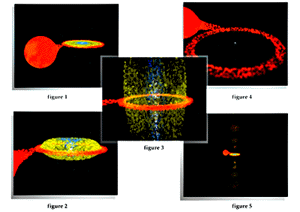Imagine the Universe! News Desk
"Old Faithful" Black Hole Movie

Credit: NASA
The above images are taken from a computer animation sequence that depicts the periodic disruption of a disk of matter surrounding a black hole in our Galaxy. In the first image, the black hole, called GRS 1915+105, is orbiting a massive "companion" star, depicted as a red sphere on the left. The black hole's powerful gravity pulls hot gas from the surface of the companion star. This hot gas forms a disk as it orbits the black hole, much like soap suds swirling down a bathtub drain. Called an accretion disk, it is represented by a multi-colored disk to the right of the companion star. As gas falls into the black hole, it is compressed and heated to millions of degrees, emitting light of various colors, which correspond to different temperatures. The hottest material, depicted as a blue/white area in the center of the multi-colored disk, is closest to the black hole and emits ultraviolet light and X-rays.
In the second image, a disruption of some kind, which is not well understood at this time, is transmitted through the gas in the disk. Eventually, the disruptions become so severe that they cause the gas in the disk to be ejected in opposite directions from the black hole, in jets at nearly the speed of light (approximately 650 million miles per hour). This process is shown in the third image. After the ejection, the center disk, begins to draw more gas toward itself again (image four). The entire process repeats every half hour, forming jet-like structures when seen from a distance (image five).
The amount of gas ejected in each cycle has a mass of about 100 trillion tons. The ejection of this much matter at such a high velocity requires an amount of energy approximately equal to six trillion times the annual U.S. energy consumption.
![]() Show me the movie!
Show me the movie!

